If you’re looking for privacy in your home or office, obscure glass may be the right solution. But what is obscure and frosted glass? In this blog post, we will answer all of your questions about obscure and frosted glass!
Obscure (frosted or textured) glass is a convenient substitute for blinds and drapes providing privacy in your home or office while still admitting light.
The importance of light
Light is a vital part of the modern environment. Whether in homes, offices, or businesses natural daylight streaming through large windows is a key factor in promoting physical and mental wellbeing.
But all those windows come with the disadvantage that people can see in and spy on what you are doing. Curtains and blinds require maintenance and cleaning so more and more smart homeowners are using obscure glass to get the privacy they need.
As an Amazon Associate, I earn from qualifying purchases
What are the main applications of obscure glass in the home?
Exterior bathroom windows are a major application – the condensation in the bathroom makes blinds impractical whereas obscure glass can be wiped dry.
Inside the bathroom or shower area, obscure glass is used as a privacy screen for modest bathers.
A major functional use of obscure glass is in front doors and entryways. In modern, open-plan homes a snooper can see right through the house without the benefit of frosted or obscure glass in the door or sidelites:
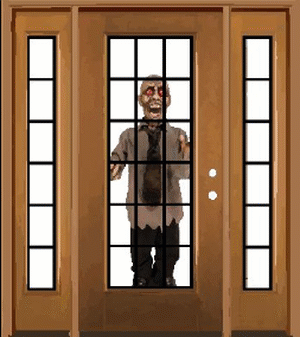
Skylites are another application for obscure glass. The possibly ugly interior structure of the skylite cavity with bugs & cobwebs is hidden from view while plenty of light is available to illuminate the room.
Offices and commercial buildings
Dividing panels between office cubicles are a favorite application of obscure glass.
In some cases, such as in the UK, it is required by law that a certain level of obscurity be present in windows that face a public street. This is to protect the privacy of people who are working inside the building.
Types of obscure glass
Obscure is the name given to any glass that is not clear, transparent, or opaque. Obscure glass includes various types of frosted or textured glass. Note that it is distinguished from transparent glass that can be any color or tint but can be seen through. And it is also quite different from opaque glass which can be any color or texture but does not transmit light.
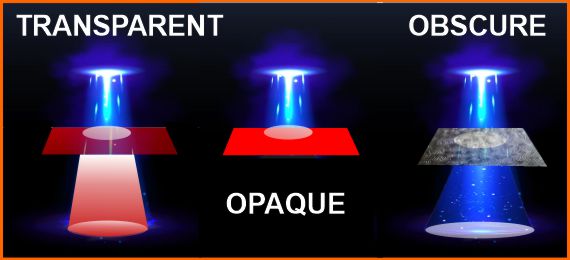
Obscure glass diffuses the view while still admitting light. Different levels are available from slightly to completely obscure.

What affects the obscurity of glass?
1) Density of texture
The density of the texture or frosting on the glass is the main control of the degree of obscurity. For example, of the two textures below, waterglass is semi-obscure, and double gluechip is very obscure.
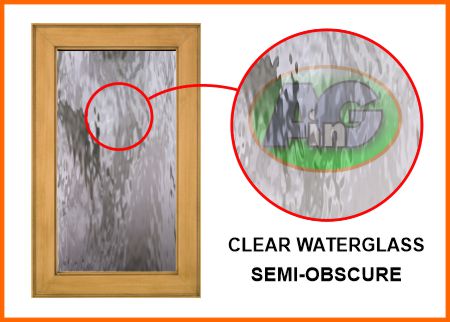
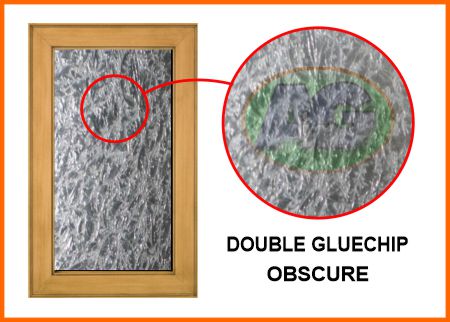
It is always best to examine textured glass “in-person” to satisfy yourself that you are getting the degree of privacy that you want.
2) Proximity to the glass
The diffusion of light rays increases with the distance from the window. So objects right up against the glass will still be more or less visible – even with obscure textured glass. Test this effect by examining glass in your friendly local glass shop.
3) Intensity of lighting
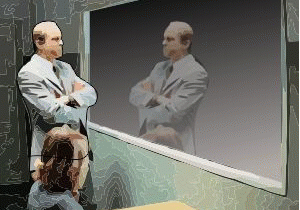
A two-way mirror shows the effect of lighting on visibility. The suspect in the interrogation room is visible when the room is brightly lit. The same principle applies to textured, obscure glass.
Even with obscure glass, you will be more or less visible if you are inside a brightly lighted house on a dark night.
Types of obscure glass
The two major types of obscure glass are frosted and textured. Both may be referred to as translucent because they transmit light but unlike transparent glass, they diffuse or obscure the image.
Frosted obscure glass
Completely frosted glass provides maximum privacy for bathroom windows and entryways.
Frosted glass is made either by etching with acid or by sandblasting with abrasive grit. Read the detailed difference between sandblasting and acid etching in this post. In both types, etching and sandblasting, the modified surface texture diffuses light to create a white frosting that lets light in but obscures the view.
Frosted glass can be incorporated into decorative panels with a wide variety of designs. Study this post to learn how to commission an etched glass window. To achieve obscurity the etched glass panel must be mainly frosted.
Acid etching has a finer surface finish and is easier to keep clean. Sandblasted glass, by contrast, has a surface made up of micro-craters that can trap dirt.
Textured obscure glass
There are two main types of textured obscure glass – architectural or art glass. Architectural glass is made specifically for windows and doors, while art glass is designed to be used as decorative elements in stained glass windows or cabinet doors.
On a budget – cannot afford obscure glass? Frugal customers or apartment renters can economize by sticking up their own static-cling frosted film for instant and affordable privacy (available on Amazon).
Architectural obscure glass
The crucial benefit of architectural glass is that it is thick and strong enough to be tempered. Glass starts out annealed and can then be tempered to make it safe and strong enough for use in windows and doors in public and private buildings. Study this post to learn all about tempered glass.
In contrast, textured art glass is thinner (generally 1/8″ thick) more fragile and cannot be tempered.
Types of architectural obscure glass
Most architectural obscure glass is textured – that is – it has a smooth top side and a patterned side produced by pressing the molten glass into a metal mold. Some commonly available textured obscure glasses are illustrated in the images below:
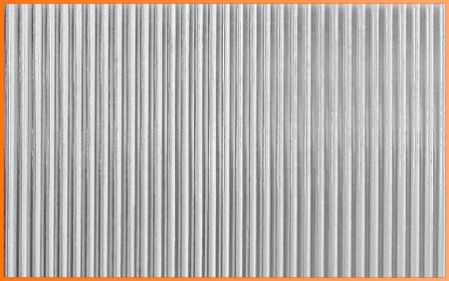
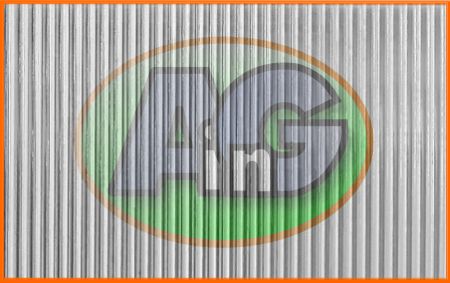

Reeded glass consists of 1/2″ wide deep embossed “reeds” and comes in 5/32″ and 3/16″ thickness. It is popular for contemporary/modern décor in cabinet doors and partitions.
Rain or Niagara glass has deep irregular striations and is popular in shower enclosures – jump to this section for pricing of rain glass.
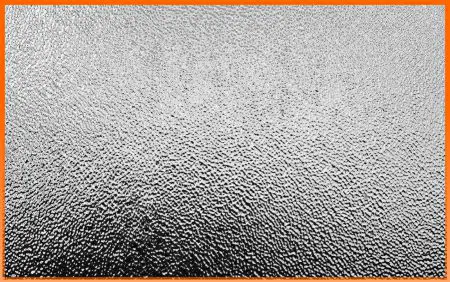
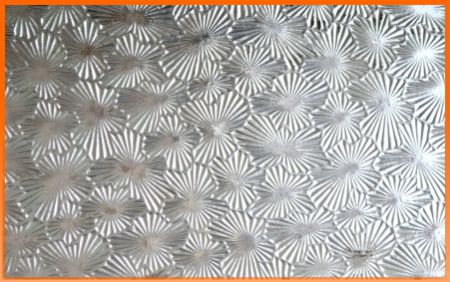

Pattern 62 ( also known as obscure) glass is a finely stippled textured glass that offers perfect obscurity but is somewhat industrial in style – not recommended for an up-scale residence.
Floralite (sometimes call florentine) is a heavily textured glass that is made up of conjoined starbursts. Very common in Victorian-era windows it forms part of this class Tucson skylight:
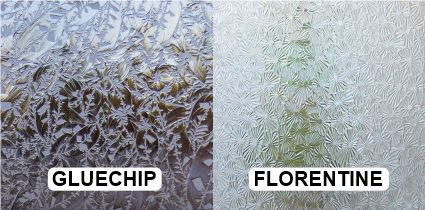
Two common types of textured glass are combined for obscurity in this Victorian-era Tucson skylight.
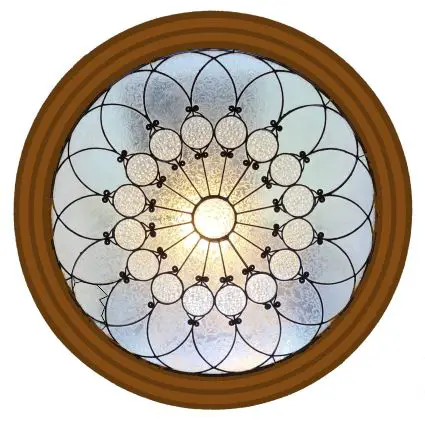
See how Artistry in Glass completed a difficult repair on this classic obscure glass skylight:
Special cast glass
Cast glass is an expensive type of obscure glass characterized by thick, bold textures and patterns. It is manufactured by pouring molten (generally clear), glass into metal molds and cooled in large kilns.
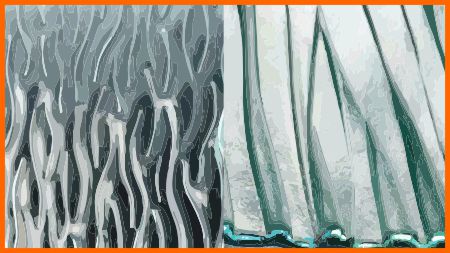
Cast. or kiln-formed, glass is custom made in small batches for decorative shower panels, room dividers, and countertops. Costs are high – $50.00 per square foot or more.
Textured art glass
Art glass can also be obscure, but there are many more options available. You can find art glass in a variety of colors, textures, and designs. And because it isn’t made for windows and doors, art glass typically doesn’t have the added benefits of being heat-strengthened.
Typical art glass is only 1/8″ thick and comes in small sheets (often 24 * 48) so is used for stained glass panels and small cabinet doors.


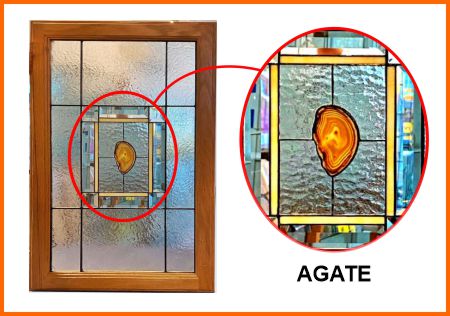
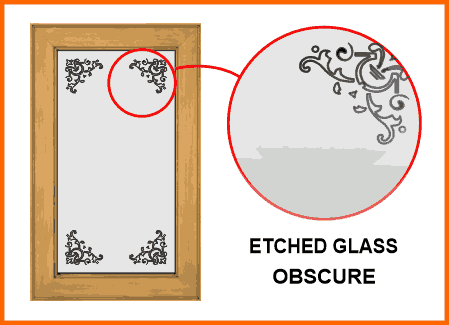
Stained glass and etched glass can also be used to provide privacy/obscurity. Read these interesting posts to learn how to commission a stained glass panel and also how to commission an etched glass panel.
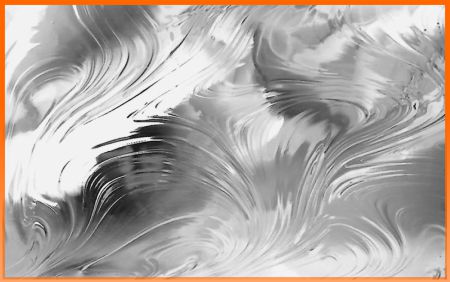
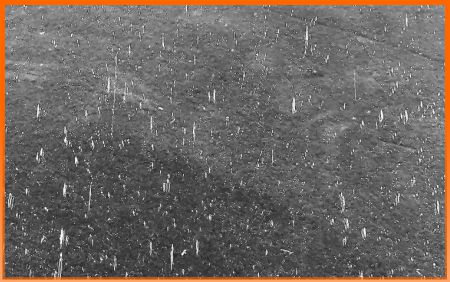
Baroque and seedy are types of textured glass that provide minimum obscurity and are commonly used in art glass panels or cabinet doors.
Two other popular textures are waterglass and granite which are shown in the video of an interior office door panel constructed by Artistry in Glass.
Opaque or spandrel glass
Unlike vision glass, which is meant to be transparent, spandrel glass is designed to be opaque in order to help hide features between the floors of a building, including vents, wires, slab ends, and mechanical equipment.
In multi-story buildings, the area between the floors is called spandrel. When a building has a full glass envelope with a continuous appearance, the glass obscuring the spandrel areas is referred to as spandrel glass. Spandrel glass used on the exterior of a building is tempered and insulated, to ensure it provides properties like those an actual wall would provide.
Spandrel glass is generally made by firing a ceramic frit — a material used as a basis for glassmaking — directly onto the surface of the glass. The frit fuses to form a permanent and strong layer that will resist weathering and not fade or warp with time.
A beneficial feature of spandrel glass is that it can create an attractive and uniform color for the building envelope. Popular colors are green and blue which harmonize and reflect skies and vegetation.
Pricing of annealed and tempered rain glass
Always examine samples of obscure glass “in person”, in your local glass and mirror shop, to make sure the degree of privacy is correct for your application.
Obscure glass can be used to your advantage in both residential and commercial properties. It is a great way to add privacy while still allowing light in. If you are interested in adding obscure glass to your home or business, contact Artistry in Glass today. We would be happy to discuss your options and help you choose the perfect style of obscure glass for your needs.
All you need to know about art glass
Commissioning stained and etched glass
- Stained glass designs from Artistry in Glass
- How to commission a stained glass window – complete advice
- How to commission an etched glass window
- How to choose the best stained glass design
- Etched or stained glass – which is better for your home?
- How much does stained glass cost?
- How much does etched glass cost?
Technical information
- Is leaded glass dangerous? Learn the facts.
- How to replace broken patio table glass
- Plexiglass and glass – what are the pros and cons?
- What is plexiglass used for?
- What costs more – glass or plexiglass?
- Preservation of stained glass in churches & synagogues
- How does stained glass get colored? learn from an expert!
- Is your broken stained glass panel worth repairing?
- How to protect stained glass in religious buildings
- How to care for and clean stained glass
- How to repair cracked stained glass
- What is Dalle de Verre?
- How to repair Dalle de Verre
- What to do about bowed & sagging stained glass
- How to care for a stained glass skylight
- Can my stained glass lampshade be repaired?
- What is the difference between sandblasting & etching?
- Obscure and frosted glass – all you need to know!
- How to save money when buying glass
- Glossary of important terms used in decorative glass
- 14 Ways to sell stained glass
- What is imitation or faux stained glass?
Guides to stained glass design
- Guide for designing abstract stained glass
- Why choose abstract contemporary stained glass
- How to design a Frank Lloyd Wright-style window
- Designing a WWII-era stained glass Waco glider
- Stained glass and Black Lives Matter
- How Is stained glass used today?
Unique Mirror Resources from Artistry in Glass
Mirror Design & layout
- How are mirrors made?
- What is a beveled mirror?
- What is a two-way mirror?
- Best mirrors for bedrooms
- How to size and position your wall mirror
- How to order custom etched mirrors
- Best places to hang dining room mirrors
- How much do wall mirrors cost?
- Shop the MIRROR Family Package
Mirror Installation & Removal
- How to hang a wall mirror
- How to frame a builder’s grade bathroom mirror
- How to hang a frameless mirror with glue
- Best clips for hanging mirrors
- How to attach a mirror to a closet door
- How to remove a mirror glued to the wall



